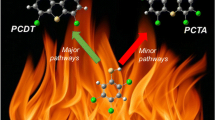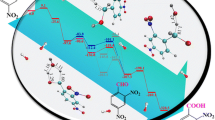Abstract
Density functional theory calculations were performed to gain insight into the mechanism and kinetic studies of homogeneous gas-phase formation of polychlorinated dibenzodioxins and polychlorinated dibenzofurans (PCDD/Fs) via aliphatic hydrocarbons (C2H2, C2H4, C3H6 and C4H8). The calculated results demonstrated that the intra-annular elimination of H is the rate-determining step throughout the reaction chain; the presence of ortho-Cl increases the abstraction barrier of arene H and decreases the reactivity of the molecule. The phenoxy radicals undergoes dimerization via carbon–carbon or carbon–oxygen coupling to form PCDD/Fs and the two coupling pathways are competitive. Our work indicates that aliphatic hydrocarbons are less reactive precursors in PCDD/F formation compared with chlorophenoxy radicals and phenoxy radicals among primary precursors of PCDD/Fs. The results presented here could be used to evaluate the contribution of aliphatic hydrocarbons acting as precursors to PCDD/Fs formation.




Similar content being viewed by others
References
Folgueras MB, Alonso M, Díaz RM (2013) Influence of sewage sludge treatment on pyrolysis and combustion of dry sludge. Energy 55:426–435
Harrison EZ, Oakes SR, Hysell M, Hay A (2006) Organic chemicals in sewage sludges. Sci Total Environ 367:481
Singh A, Agrawal M (2008) Acid rain and its ecological consequences. J Environ Biol 29:15–24
Weber R, Hagenmaier H (1999) Mechanism of the formation of polychlorinated dibenzo-p-dioxins and dibenzofurans from chlorophenols in gas phase reactions. Chemosphere 38:529–549
Choate CE (2010) Systems and methods for combining and converting solid and liquid organic waste materials into useful products
Margallo M, Taddei MBM, Hernández-Pellón A, Aldaco R, Irabien Á (2015) Environmental sustainability assessment of the management of municipal solid waste incineration residues: a review of the current situation. Clean Techn Environ Policy 17:1333–1353
Shibamoto T, Yasuhara A, Katami T (2007) Dioxin formation from waste incineration. Rev Environ Contam Toxicol 190:1–41
Park MH, Kim HJ, Lee MG, Park SH, Lee YC, Chung DY (2011) Nature and fate of dioxin in soil environment. Korean J Soil Sci Fert 44:657–661
Lambert MK, Friedman C, Luey P, Lohmann R (2011) Role of black carbon in the sorption of polychlorinated dibenzo-p-dioxins and dibenzofurans at the diamond alkali superfund site, Newark Bay, New Jersey. Environ Sci Technol 45:4331–4338
Sun Y, Sun Y, Wang D (2016) Research on revision of dioxin exhaust emission factor from waste incineration industry. Environ Sci Manag
Zhao X, Zhu W, Huang J, Li M, Gong M (2015) Emission characteristics of PCDD/fs, PAHs and PCBs during the combustion of sludge-coal water slurry. J Energy Inst 88:105–111
Addink R, Bakker WCM, Olie K (1995) Influence of HCl and Cl2 on the formation of polychlorinated dibenzo-p-dioxins/dibenzofurans in a carbon/fly ash mixture. Environ Sci Technol 29:2055–2058
Ke S, Yan JH, Li XD, Lu SY, Wei YL, Fu MX (2010) Experimental study on the effects of H(2)O on PCDD/Fs formation by de novo synthesis in carbon/CuCl(2) model system. Chemosphere 78:672
Qu X, Wang H, Zhang Q, Shi X, Xu F, Wang W (2009) Mechanistic and kinetic studies on the homogeneous gas-phase formation of PCDD/fs from 2,4,5-trichlorophenol. Environ Sci Technol 43:4068–4075
Khachatryan L, Ruben Asatryan A, Dellinger B (2011) An elementary reaction kinetic model of the gas-phase formation of polychlorinated dibenzofurans from chlorinated phenols. J Phys Chem A 108:9567–9572
Yang X, Liu H, Hou H, Flamm A, Zhang X, Wang Z (2010) Studies of thermodynamic properties and relative stability of a series of polyfluorinated dibenzo-p-dioxins by density functional theory. J Hazard Mater 181:969
Qu R, Liu H, Zhang Q, Flamm A, Yang X, Wang Z (2012) The effect of hydroxyl groups on the stability and thermodynamic properties of polyhydroxylated xanthones as calculated by density functional theory. Thermochim Acta 527:99–111
Lee C, Yang W, Parr RG (1988) Development of the Colle-Salvetti correlation-energy formula into a functional of the electron density. Phys Rev B Condens Matter 37:785–789
Dar T, Shah K, Moghtaderi B, Page AJ (2016) Formation of persistent organic pollutants from 2,4,5-trichlorothiophenol combustion: a density functional theory investigation. J Mol Model 22:1471–1475
Truhlar DG, Garrett BC, Hipes PG, Kuppermann A (1984) Test of variational transition state theory against accurate quantal results for a reaction with very large reaction-path curvature and a low barrier. J Chem Phys 81:3542–3545
Yamanaka H, Hamada R, Nibuta H, Nishiyama S, Tsuruya S (2002) Gas-phase catalytic oxidation of benzene over cu-supported ZSM-5 catalysts: an attempt of one-step production of phenol. J Mol Catal A Chem 178:89–95
Kato CN, Hasegawa M, Sato T, Yoshizawa A, Inoue T, Mori W (2005) Microporous dinuclear copper (II) trans-1, 4-cyclohexanedicarboxylate: heterogeneous oxidation catalysis with hydrogen peroxide and X-ray powder structure of peroxo copper (II) intermediate. J Catal 230:226–236
Vilhunen S, Puton J, Virkutyte J, Sillanpää M (2011) Efficiency of hydroxyl radical formation and phenol decomposition using UV light emitting diodes and H2O2. Environ Technol 32:865–872
Dar T, Altarawneh M, Dlugogorski BZ (2012) Theoretical study in the dimerisation of 2-chlrothiophenol/2-chlorothiophenoxy: precursors to PCDT/TA. Organohalogen Compd 74:657–660
Altarawneh M, Dlugogorski BZ, Kennedy EM, Mackie JC (2009) Mechanisms for formation, chlorination, dechlorination and destruction of polychlorinated dibenzo-p-dioxins and dibenzofurans (PCDD/fs). Prog Energ Combust 35:245–274
Zhang Q, Yu W, Zhang R, Zhou Q, Gao R, Wang W (2010) Quantum chemical and kinetic study on dioxin formation from the 2,4,6-TCP and 2,4-DCP precursors. Environ Sci Technol 44:3395–3403
Gao R, Xu F, Li S, Hu J, Zhang Q, Wang W (2013) Formation of bromophenoxy radicals from complete series reactions of bromophenols with H and OH radicals. Chemosphere 92:382–390
Kupka T, Mancini M, Irmer M, Weber R (2008) Investigation of ash deposit formation during co-firing of coal with sewage sludge, saw-dust and refuse derived fuel. Fuel 87:2824–2837
Acknowledgments
This work was supported by Beijing Natural Science Foundation (2182066), Natural Science Foundation of Hebei Province of China (B2018502067).
Author information
Authors and Affiliations
Corresponding author
Electronic supplementary material
ESM 1
(DOCX 1082 kb)
Rights and permissions
About this article
Cite this article
Gao, Z., Sun, Y., Li, M. et al. Mechanism and kinetic analysis of PCDD/Fs formation from aliphatic hydrocarbons (C2H2, C2H4, C3H6, C4H8) precursors. J Mol Model 24, 267 (2018). https://doi.org/10.1007/s00894-018-3807-4
Received:
Accepted:
Published:
DOI: https://doi.org/10.1007/s00894-018-3807-4




